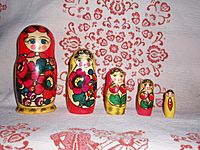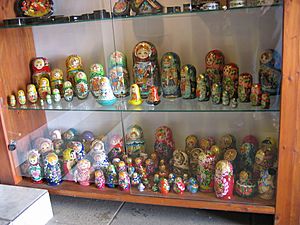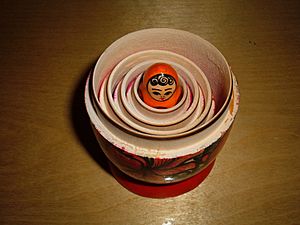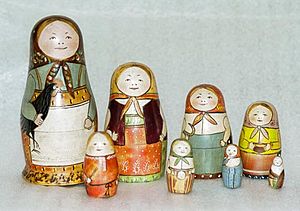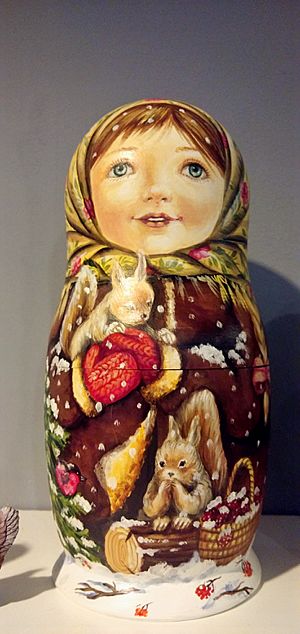Matryoshka facts for kids
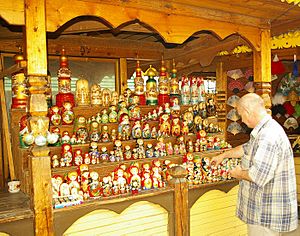
Matryoshka dolls are special wooden dolls that fit one inside another. People also call them stacking dolls, nesting dolls, or Russian dolls. The word matryoshka comes from an old Russian girl's name, Matryona. It means "little matron" or "mother."
A set of matryoshka dolls usually has a wooden figure that opens in the middle. Inside, you find a smaller doll, and inside that one, an even smaller doll. This continues until you reach the tiniest doll, which is a solid piece of wood.
The first Russian nesting doll set was made in 1890. A skilled woodworker named Vasily Zvyozdochkin carved it. The design came from Sergey Malyutin, a folk artist. Usually, the outside doll is a woman wearing a traditional Russian dress called a sarafan. The dolls inside can be boys or girls. The smallest doll is often a baby. The painting on each doll is very detailed and artistic.
These dolls often have a special theme. Themes can be anything from fairy tale characters to famous leaders. In some countries, people call them babushka dolls. However, in Russian, babushka (бабушка) means "grandmother" or "old woman."
Contents
Discovering Matryoshka Dolls
The very first Russian nesting doll set was created in 1890. It was made at a place called the Children's Education Workshop. Vasily Zvyozdochkin carved the dolls. Sergey Malyutin, a folk artist, designed how they looked. This workshop belonged to Savva Mamontov, a rich Russian businessman who loved art.
Mamontov's brother, Anatoly, started the workshop to make and sell toys for children. Malyutin painted the first doll set. It had eight dolls. The biggest doll was a mother in a traditional dress, holding a rooster. Inside were her children, both girls and a boy. The smallest doll was a baby.
The Children's Education Workshop closed in the late 1890s. But the idea of matryoshka dolls moved to Sergiyev Posad. This Russian city has been famous for making toys since the 1300s.
Historians are not completely sure where the idea for matryoshka dolls came from. Some believe Zvyozdochkin and Malyutin were inspired by dolls from East Asia. For example, the Honshu doll from Japan is a possibility. However, Honshu dolls do not fit inside each other. Other ideas include a hollow daruma doll or a Seven Lucky Gods nesting doll.
Savva Mamontov's wife showed the dolls at a big exhibition in Paris in 1900. The toy won a bronze medal there. Soon after, matryoshka dolls became popular. They were made in many places across Russia and sent all over the world.
How Matryoshka Dolls Are Made
Matryoshka dolls are usually made from linden wood. Many people think they are carved from one single piece of wood, but that's not true. They are made using a special machine called a lathe. This machine helps shape the wood.
Woodworkers use different types of chisels to carve the dolls. They also use special handmade wooden tools called "calipers." These calipers help make sure each doll is the right size to fit inside the next. Village blacksmiths often make these tools by hand. Each set of wooden calipers is unique. Many pieces of wood are carefully carved to create a nesting set.
Fun Themes for Matryoshka Dolls
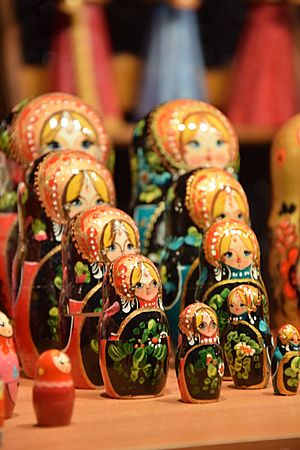
Matryoshka dolls often have a special theme. For example, they might show peasant girls in traditional clothes. Long ago, themes often came from old traditions or fairy tales. But since the late 1900s, artists have used many more ideas. These include Russian leaders and other famous people.
Common themes for matryoshkas are flowers and nature scenes. You can also find dolls with Christmas, Easter, or other religious themes. Modern artists create many new styles. These are popular souvenirs for tourists. Some themes include animal collections, portraits, and funny drawings of famous politicians, musicians, athletes, or movie stars.
Some Russian artists focus on painting themed matryoshka dolls. They might specialize in certain subjects, people, or nature scenes. Famous places for matryoshka styles include Sergiyev Posad, Semionovo (now Semyonov), Polkhovsky Maidan, and the city of Kirov.
Matryoshka Dolls of Leaders
In the late 1980s and early 1990s, Russia went through a time of big changes called Perestroika. During this time, people had more freedom to express themselves. Because of this, leaders of the Soviet Union became a popular theme for matryoshka dolls. The largest doll often showed the leader at that time, Mikhail Gorbachev. These dolls became very popular and were sometimes called Gorba or Gorby dolls.
After the Soviet Union broke apart, new Russian leaders came to power. So, newer doll sets started to feature Russian presidents like Boris Yeltsin, Vladimir Putin, and Dmitry Medvedev.
Most sets show the current leader as the biggest doll. The dolls inside get smaller and show past leaders. These might include Leonid Brezhnev, Nikita Khrushchev, Joseph Stalin, and Vladimir Lenin. Sometimes, even old Russian rulers called Tsars like Nicholas II and Peter the Great are included. Leaders like Yuri Andropov and Konstantin Chernenko are rarely seen because they were in power for a very short time.
Sometimes, a less common set might show the current leader as the smallest doll. Then, the past leaders get bigger, with Stalin or Lenin as the largest doll. During Medvedev's time as president, both Medvedev and Putin might be on the largest doll. This was because Putin still had an important role as Prime Minister of Russia. Now that Putin is president again, Medvedev usually comes after Yeltsin and before Putin in the stacking order.
Political matryoshka sets usually have between five and ten dolls.
Matryoshka as an Emoji
In 2020, the Unicode Consortium approved the matryoshka doll (🪆) as a new emoji character. This means you can now use it on your phones and computers! Jef Gray suggested the matryoshka emoji. He wanted a symbol that represented Russian, East European, and Far East Asian cultures. It is a symbol that is not about religion or politics.
See also
 In Spanish: Matrioshka para niños
In Spanish: Matrioshka para niños
- Amish doll
- Chinese boxes
- Daruma doll
- Fractal
- Recursion
- Culture of Russia
- Self-similarity
Images for kids
-
Bear Russian Doll


